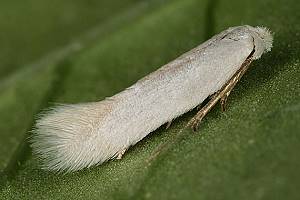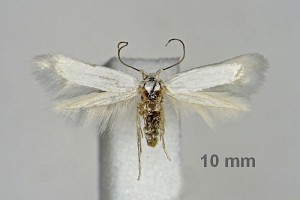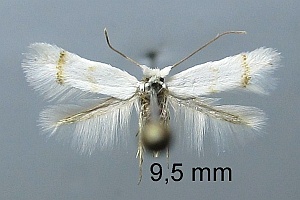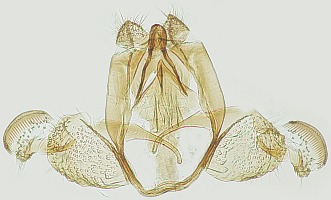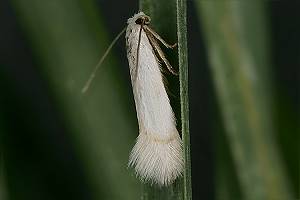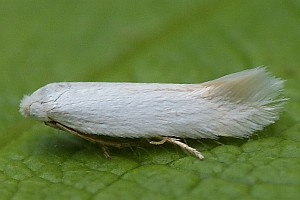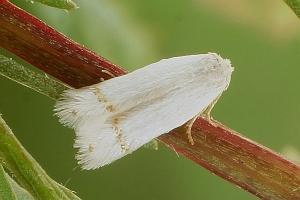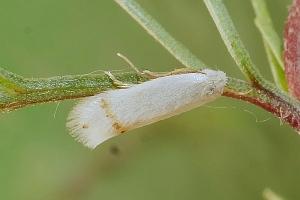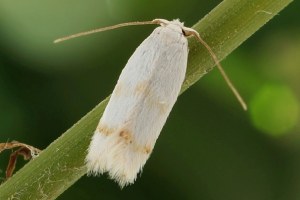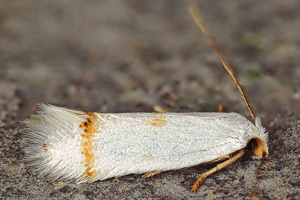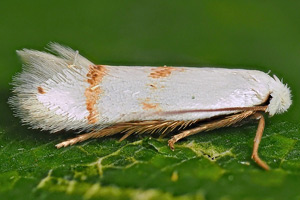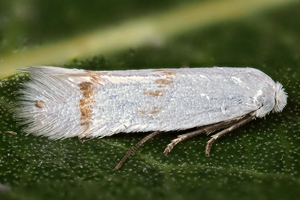

 +33Kontinente:EUAS
+33Kontinente:EUAS1. Lebendfotos
1.1. Falter
2. Diagnose
2.1. Weibchen
2.2. Geschlecht nicht bestimmt
2.3. Genitalien
2.3.1. Männchen
2.4. Erstbeschreibung
3. Biologie
3.1. Nahrung der Raupe
- [Polygonaceae:] Rumex acetosella (?) (Kleiner Sauerampfer (?))
- [Polygonaceae:] Rumex scutatus ? (Schildampfer ?)
In der Literatur und in Internetquellen findet sich durchweg Rumex acetosella (Kleiner Sauerampfer) als Nahrungspflanze der Raupe. Ob dies nur eine naheliegende Vermutung ist, oder ob hier tatsächlich Freilandfunde (von wo?) zu Grunde liegen, wird dabei nicht klar. Gleiches gilt für Rumex scutatus (Schildampfer) - eine Pflanze, die den meisten Fundorten des Falters fehlen dürfte. Bei Regier et al. (2015) heißt es: "The other common European species, O. salaciella Treitschke, has been reared from Rumex L. (Polygonaceae; van Nieukerken, 1990)." Und bei Van Nieukerken (1990) findet sich dann der Hinweis auf die wohl einzige Arbeit mit konkreten Beobachtungen, zu Warren (1888) und dessen Aufsatz "The Habits of Opostega salaciella". Warren (1888) schreibt darin: "I am glad to be able to record the accidental breeding of O. salaciella, Tr., and the name of its probable food-plant. In a bag containing the roots and plants of Rumex acetosella, from which I was breeding Gelechia peliella, Tr., I found in July a single specimen of salaciella, just emerged, and when the rubbish was subsequently tourned out, a second dead and dried specimen of the same insect was discovered. No other plant besides the Rumex had been introduced into the bag, so that, I think, we may safely conclude that this is its food-plant; and it probably feeds among the flowers or in the flower-stalk." Wie kommt Warren zu seiner Vermutung? Er erklärt: "For having observed that the peliella larvae were in the habit of emerging at night from their silken tubes at the base of the plants, and spinning fine threads up the stems to the flower-heads on which they fed, I replenished the original stock of food with a bunch of fresh flower-stems, and I think it most probable that in these last the salaciella larvae were hidden. The plant grows freely in all the localities where the perfect insect is usually met with." Es spricht also alles dafür, dass die Raupe irgendwo am Kleinen Sauerampfer lebt - wo ist aber auch 130 Jahre nach Warrens Zucht-Unfall keineswegs klar. Zu Rumex scutatus ist mir keine konkrete Quelle bekannt.
(Autor: Erwin Rennwald)
4. Weitere Informationen
4.1. Andere Kombinationen
- Elachista salaciella Treitschke, 1833 [Originalkombination]
4.2. Synonyme
- Opostega reliquella Zeller, 1848
4.3. Literatur
- Nieukerken, E.J. van (1990): Opostegidae. — S. 357-372. In: Johansson, R., Nielsen, E.S., Nieukerken, E.J. van & B. Gustafsson (1990): The Nepticulidae and Opostegidae (Lepidoptera) of North West Europe. – 739 S.; Fauna Entomologica Scandinavica, Volume 23, part 1 & part 2; Leiden, New York, København & Köln (E. J. Brill / Scandinavian Science Press Ltd.).
- Erstbeschreibung: Treitschke, F. (1833): Die Schmetterlinge von Europa 9 (2): 1-294. Leipzig (Ernst Fleischer).
- Warren, M.A. (1888): The habits of Opostega salaciella, TR., &c. — The Entomologist's Monthly Magazine, 25: 145-146.
































